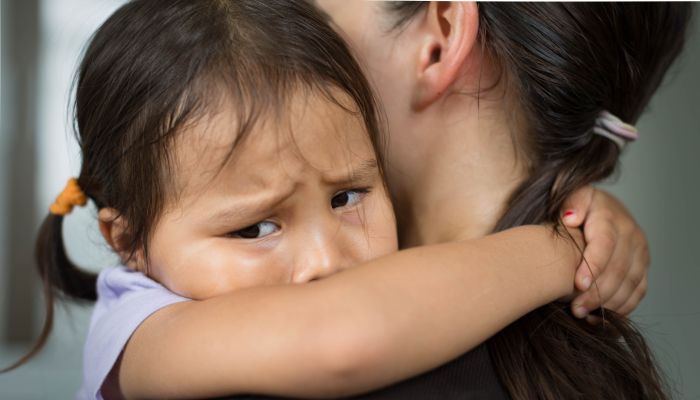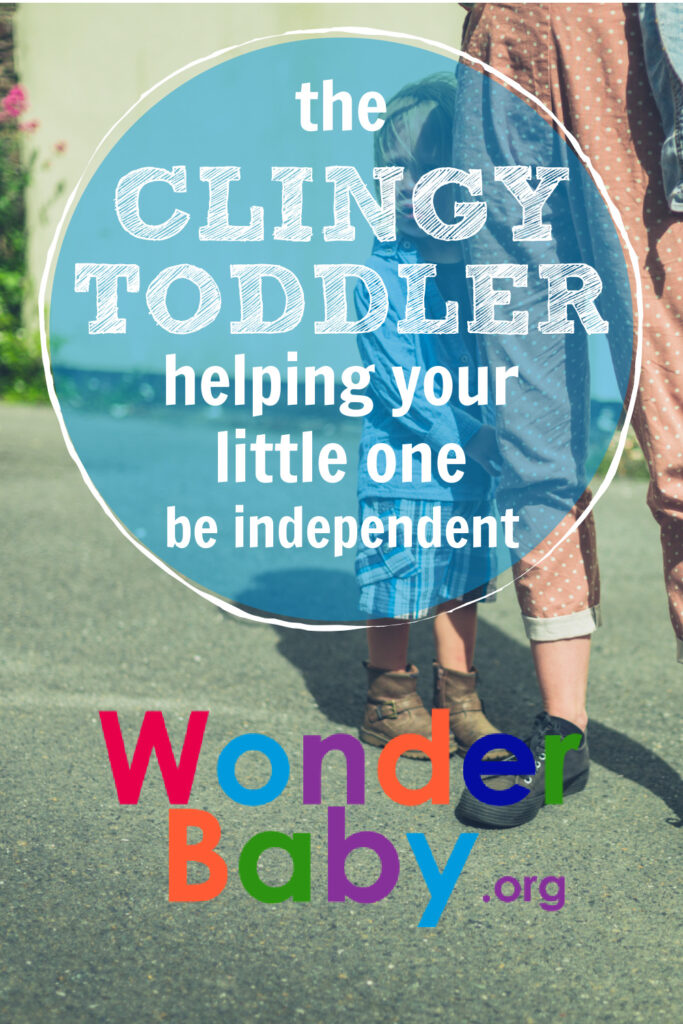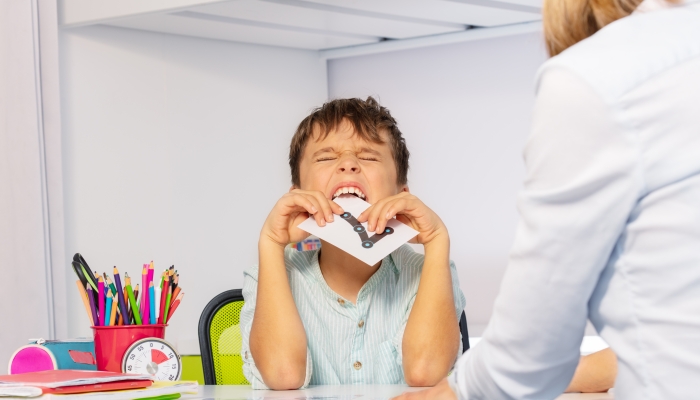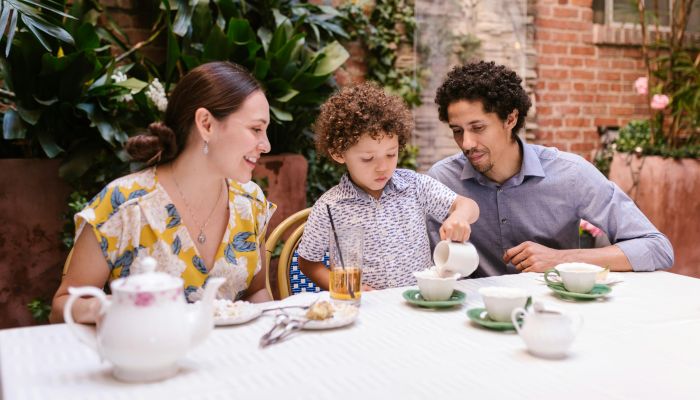The Clingy Toddler: Helping Your Little One Be Independent

- You might notice your child displaying clingy behaviors between the ages of 6 months up to 3 years of age.
- A clingy baby or toddler is a result of the healthy bond between parent and child.
- If your child clings to you when it’s time for you to leave, give them reassurance that you will return.
- Consistent, positive routines let your toddler know what to expect with each departure.
Is your little one spending more time wrapped around your leg than usual? If so, your clingy toddler might be entering a new stage of childhood development.
When your young child enters the clingy toddler phase, you’ll know by their behaviors. You might notice they no longer reach for their caregiver with a smile at drop-off. Your clingy child may even grasp on to you like a spider monkey when you try handing them off to grandparents.
What’s the deal?
These sudden changes in behavior may cause concern for parents and caregivers alike. If you have a strong-willed toddler on top of that, it may seem like this clingy stage will never end!
Don’t fret! There’s good news!
You can avoid stress by understanding the basics behind your toddler’s clingy behavior. With the right tools to help your precious one cope and strategies for long-term success, you’ll be on the right path!

Why is My Toddler So Clingy?
You might notice your toddler displaying clingy behaviors between the ages of 6 months up to 3 years of age. This anxiety of separation may start without warning, causing you to question the reason. Taking a look at the basic development of young children will shed light on this sudden change.
Starting at birth, your baby has an instinct to identify and form a secure attachment with their caregivers. These bonds revolve around security and trust. In the first 3 months of your young child’s life, it’s physical touch that provides this sense of comfort and safety.
At around 6 months of age, babies discover something called object permanence. Object permanence is the awareness that objects still exist even though they can not be seen.
With this new knowledge, your baby pays closer attention to who leaves the room. When you or your spouse walk away, they might cry to express their fear that you may not return. Without a firm grasp on the concept of time, an hour might as well be a day for your baby!
As your baby becomes a toddler, this separation awareness increases. When your toddler senses you leaving, you’ll notice a rise in clingy behavior. Your leaving the room is much like taking a pacifier or stuffed animal away.
The primary reason babies and toddlers cry for mom or dad is because they see their parents as their main source of security and safety.
If you suspect another cause behind your child’s clinginess, some other triggers include:
- Adding a new sibling to the home
- Moving to another house
- Traveling to new places
- Parents going through divorce or separation
- Starting daycare
- Feeling tired, hungry, or sick
Pay attention to any new or recent changes in your life that may have affected your child’s normal routine. Your child will need extra love and affection during these times.
Is It Normal for Toddlers to be Clingy?
A toddler who clings to mom, dad, or other caregivers is completely normal. The clingy stage of childhood is a healthy milestone in toddler development.
It’s important to remember that your child’s behaviors are a result of the strong bond between you and your child. Think of this as a compliment!

How Can I Help My Toddler Be Less Clingy?
If you’re exhausted or feeling overwhelmed from parenting in the clingy toddler phase, rest easy. There are many strategies you can put in place to ease worries and help your child feel secure.
- Give Eye Contact and Reassurance
If your little one clings to you when it’s time to leave them in child care, give them reassurance that you will return. Try looking them in the eyes, speaking calmly, and reminding them of where you are going.
As you explain your plans to your child, smile and keep the conversation positive. Remind your toddler of your love for them and of all the fun they will have while you are away. This small step may be the little extra support clingy toddlers need to feel comfortable.
- Hug Your Child
Research shows that physical contact has a positive impact on the behavior of children. Studies suggest emotional and behavioral problems are less likely in children who are hugged often.
Holding your child near gives them reassurance of your love as well as a boost in the hormone oxytocin. This amazing hormone promotes feelings of happiness while decreasing stress or anxiety.
Hold your child close for at least 20 seconds to activate happy hormones. This heart-warming hug will also reduce stress and calm any anxious parenting woes you may have.
- Keep Goodbyes Brief and Consistent
Most toddlers have a hard time with goodbyes. These partings are best handled with brief, positive routines. Prolonging your exit may only increase anxiety and create inconsistency in routine.
Instead, try creating a positive routine that your child will look forward to. For example, when you drop your clingy child at child care, you might hug your child, kiss their head, and repeat a familiar phrase such as, “I love you very much and will be back soon!”
Consistent, positive routines let clingy toddlers know what to expect with each departure. This familiar pattern helps to ease any feelings of anxiety or fear.
- Provide Opportunities for Separation
Many parents may try to avoid leaving their clingy children to keep them happy. No parent likes to see their child upset, but this may only prolong the clingy phase.
Don’t be tempted to avoid all situations that would separate you from your child. Remember that the goal is for them to gain independence and develop social skills. Instead, provide safe opportunities for time away from mom or dad with a trusted caregiver.
Leaving your child with a familiar face for small amounts of time is a great place to start. A quick trip to the grocery store or an outing for dinner is a perfect occasion to allow them time away from you.
During these outings, your child’s confidence will improve as they learn how to self-soothe and cope with your absence. If you feel they need extra support with self-soothing. you might also consider providing calming sensory activities.
- Encourage Independent Play
Learning to play independently is a necessary skill for children to master. When your child plays alone, they learn how to concentrate, persist, and complete tasks—crucial strengths for life-long success. As an added bonus, solitary play will also boost creativity and strengthen your child’s imagination. The more that children play independently, the easier it gets! Before long, many kids can’t get enough of their newfound independence.
You can encourage these behaviors by setting up a play area in a separate room from where you are. For example, you might lay out blocks for your child to play with in the living room while you are in the kitchen. Or, you might give them modeling clay at the table while you are doing laundry in another room.
If your child isn’t keen on the idea of playing independently, that’s OK. Keep a consistent routine by selecting a time in your daily schedule for independent play. At that hour, set a timer and let your child know this is their special alone time. If they remain hesitant, start by setting a timer for 5 minutes and gradually build up from there.

Is Clinginess the Same as Separation Anxiety?
Clinginess and separation anxiety both describe the clingy stage of normal childhood development. However, separation anxiety shouldn’t be confused with separation anxiety disorder.
Separation anxiety disorder involves an intense fear of separation that disrupts daily activity. Talk to your child’s pediatrician if they are over 3 years of age and have extreme difficulty leaving your side.
Separation anxiety disorder may include any of the following symptoms:
- Extreme worry of being separated from family
- Elevated concern of family death or illness
- Fear of sleeping away from home
- Frequent complaints of an upset stomach, headache, other ailments
- Severe temper tantrums when leaving parents
- Nightmares about separation
- Reluctance to sleep alone
- Refusal to go to school
- Bed-wetting
What if My Toddler is Clingy at Bedtime?
If you have a clingy toddler who won’t sleep alone at bedtime, there’s no need for concern. Many children prefer to sleep with mom and dad rather than alone.
Remember that your toddler’s separation anxiety at bedtime won’t last forever and is a normal part of their development. Children need your presence to make them feel safe and secure at night. A stable bedtime routine may reduce worries and calm your little one.
When you create a nighttime routine, include activities that bring joy and a sense of peace. Reading a book, taking a bath, or singing lullabies are all great options that most kids love.
Be sure to complete this routine every night, even on the evenings when your time is short. The few extra minutes spent at bedtime will add immense security.
If your child’s nighttime behavior is more extreme, see our article on bedtime tantrums for advice on how to deal with this common problem.
Why Does My Toddler Cling to Only Mom or Dad?
It can be hard when your child clings to your spouse! A clingy toddler to mom or dad doesn’t indicate a lack of love for the other parent.
Your little one may form a secure attachment to either parent at different stages in their development. For example, babies may prefer the parent who feeds them. Then as the child grows, their preference may switch to the parent who is more fun. To achieve balance, try sharing parenting roles in your child’s daily routines. When both parents take part in routines, younger children will see them as equal sources of security.

Related Posts

Behavior
Understanding Intermittent Explosive Disorder in Children
Are you worried about your child’s unexpected aggression and explosive behaviors? Learn how to support a child with intermittent explosive disorder.

Behavior
5 Emotional Regulation Activities for Kids
Want to teach your child how to regulate emotions? Here are emotional regulation activities for kids that can help!

Behavior, Special Needs
5 Tips for Dining Out with Children Who Have Sensory Sensitivities
Worried about dining out with sensory sensitivities? Try these tips for less stress and more fun the next time you take your family out to eat.